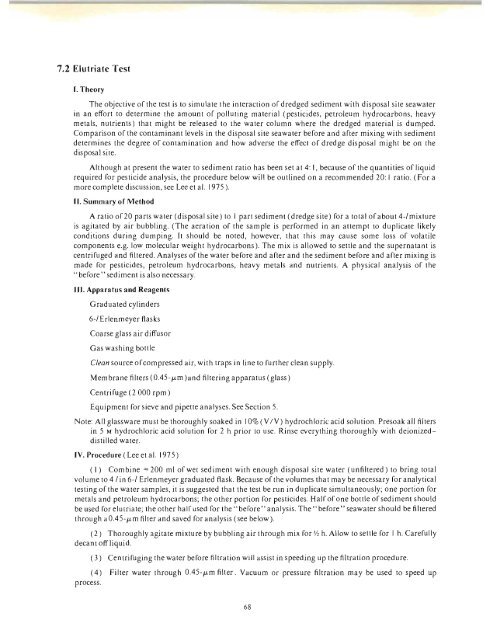You also want an ePaper? Increase the reach of your titles
YUMPU automatically turns print PDFs into web optimized ePapers that Google loves.
7.2 Elutriate Test<br />
I. Theory<br />
The objective of the test is to simulate the interaction of dredged sediment with disposal site seawater<br />
in an effort to determine the amount of polluting material ( pesticides, petroleum hydrocarbons, heavy<br />
metals, nutrients) that might be released to the water column where the dredged material is dumped.<br />
Comparison of the contaminant levels in the disposal site seawater before and after mixing with sediment<br />
determines the degree of contamination and how adverse the effect of dredge disposal might be on the<br />
disposal site.<br />
Although at present the water to sediment ratio has been set at 4: I, because of the quantities of liquid<br />
required for pesticide analysis, the procedure below will be outlined on a recommended 20: I ratio. (For a<br />
more complete discussion, see Lee et al. 1975 ).<br />
II. Summary of Method<br />
A ratio of 20 parts water (disposal site) to 1 part sediment (dredge site) for a lOlal of abou t 4-/ mixture<br />
is agitated by air bubbling. (The aeration of the sample is performed in an attempt to duplicate likely<br />
conditions during dumping. It should be noted, however. that this may cause some loss of volatile<br />
components e.g. low molecular weight hydrocarbons). The mix is allowed to settle and the supernatant is<br />
centrifuged and filtered. Analyses of the water before and after and the sediment before and after mixing is<br />
made for pesticides. petroleum hydrocarbons, heavy metals and nutrients. A physical analysis of the<br />
" before" sediment is also necessary.<br />
III. Apparatus and Reagents<br />
Graduated cylinders<br />
6-/ Erlenmeyer flasks<br />
Coarse glass air diffusor<br />
Gas washing bottle<br />
Clean source of compressed air, with traps in line to further clean supply.<br />
Mem brane filters (0.45-fLm land filtering apparatus (glass)<br />
Centrifuge (2000 rpm)<br />
Equipment for sieve and pipette analyses. See Section 5.<br />
Note: All glassware must be thoroughly soaked in 10% (V IV) hydrochloric acid solution. Presoak all filters<br />
in 5 M hydrochloric acid solution for 2 h prior to use. Rinse everything thoroughly with deionizeddistilled<br />
water.<br />
IV. Procedure (Lee et a l. 1975)<br />
(I) Combine"'" 200 ml of wet sediment with enough disposal site water (unfiltered) to bring total<br />
volume to 4/ in 6-/ Erlenmeyer graduated flask. Because of the volumes that may be necessary for analytical<br />
testing of the wa ter <strong>samples</strong>, it is suggested tha t the test be run in duplicate simultaneously; one portion for<br />
metals and petroleum hydrocarbons; the other portion for pesticides. Half of one bottle of sediment should<br />
be used for elutriate; the other half used for the " before" analysis. The" before" seawa ter should be filtered<br />
through a 0.45-fLm filter and saved for analysis (see below).<br />
(2 ) Thoroughly agitate mixture by bubbling air through mix for 1/2 h. Allow to settle for I h. Carefully<br />
decant off liquid.<br />
(3) Centrifuging the water before filtration will assist in speeding up the filtration procedure.<br />
(4) Filter water through 0.45-fLm filter . Vacuum or pressure filtration may be used to speed up<br />
process.<br />
68

















